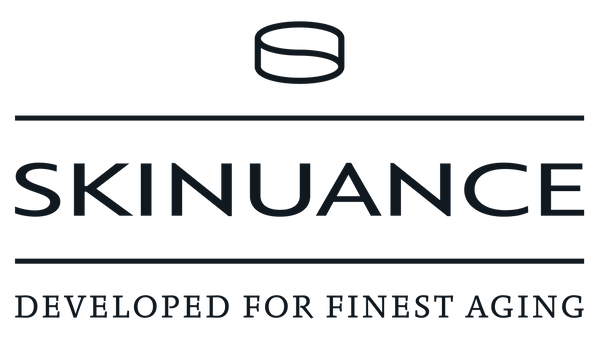
Pigment spots were yesterday – prevent and get rid of them
Freckles on the nose and cheeks look sweet and youthful, but with larger pigment spots, it's exactly the opposite: they make you look old. Along with wrinkles, these discolorations of the skin are among the most noticeable signs of skin aging. This pigmentation disorder, also known as age spots, is usually completely harmless, but is still perceived as bothersome.
How do pigmentation spots develop?
When you are exposed to the sun, UV radiation stimulates the production of tyrosinase, and the skin's own pigment melanin is produced, which is responsible for the pleasant tan. Thus, the skin actually produces melanin for its own protection against UV radiation.
This tanning effect of the upper skin layer should normally occur evenly. However, due to an uneven distribution of melanin-producing cells in the skin, there can be an increased concentration of melanin in one spot, leading to hyperpigmentation. Especially people with lighter skin types and from a certain age are more frequently affected by irregular pigment accumulations.
Pigmentation spots usually appear on the 'balconies' of the skin, on sun-exposed areas. Pigmentation spots on the face are particularly found on the cheeks, nose, and forehead. The spots on the skin also occur on the décolletage and the backs of the hands.
The trigger for pigmented skin
The predisposition to pigment spots lies in our genes and is particularly triggered by UV light. Female hormones, hormonal changes due to hormonal contraception, and certain medications (such as antibiotics or chemotherapeutics) that make the skin more photosensitive additionally trigger hyperpigmentation. Added to this are fine dust and other dirt particles in the air, especially in cities, which can further increase the excessive production of the skin pigment melanin, as the small particles are almost visually burned into the skin and lead to irregularities.
The sun doesn't have to be strong for this. Even low sunlight exposure can become a 'magnifying glass' for new pigmentation spots in combination with photosensitizing medications or hormones.
How can I prevent pigmentation spots?
The best way to prevent the formation of UV-induced pigmentation disorders is with a sunscreen that has high UVB and UVA protection. Suitable creams with naturally derived active ingredients can additionally serve as skin protection and antioxidants, ensuring an even skin appearance.
- Ectoin is a good example here: a naturally derived active ingredient, an amino acid produced by microorganisms (bacteria) that survive under extreme conditions. This effectively protects them from strong dryness, UV radiation, or high salt concentrations. As an active ingredient in care products, it serves as a guardian against UV-induced skin damage and oxidative stress.
- Vitamin E is another popular active ingredient that not only has anti-inflammatory properties and stimulates cell regeneration but also alleviates skin damage caused by UV radiation (sunburn). As a lipophilic (fat-soluble) vitamin, it has a strong antioxidant effect by binding oxygen atoms of free radicals and slowing down oxidation processes.
- And last but not least, retinol (vitamin A), which inhibits tyrosinase, thus preventing excessive melanin production and thereby preventing new pigment spots.
Our skin experts at SKINUANCE® have developed targeted products with selected active ingredients for the best possible prevention against UV light-induced pigmentation spots to optimally protect your skin:
- SKINUANCE® FLEXIBLE SUN DEFENCE 50+ with high UVB filter and extra high UVA filter.
- SKINUANCE® CALMING FACE CREAM with Ectoin.
- SKINUANCE® REGENERATING FACE CREAM with retinol.
What to do if pigment spots are already there?
If the spots are already present, fortunately there are a few effective remedies. Active ingredients like retinol or fruit acids reduce them by stimulating skin renewal and regenerating the skin barrier. But low molecular weight hyaluronic acid also helps to significantly balance existing hyperpigmentation. Retinol can suppress tyrosinase and thus reduce UV light-induced melanin production. However, it cannot change genetic influences that are responsible for deep-seated pigmentation.
- The SKINUANCE® REGENERATING FACE CREAM regenerates prematurely aged skin and reduces UV light-induced pigment shifts.
- The SKINUANCE® FRUIT ACID CREAM also promotes cell renewal. It not only refines pores and the skin's appearance but also reduces UV light-induced pigmentation disorders.
- The SKINUANCE® HYALURONIC INFUSION SERUM contains tiny hyaluronic acid molecules that hydrate the skin even in the smallest corners and have a skin tone regulating effect. Additionally, included skin-identical linoleic acid ensures an even skin tone and balances out age spots.
- The SKINUANCE® LIFTING & FIRMING FACE CREAM contains the innovative active ingredient RejuveNAD™, which not only visibly smooths and tightens lines and wrinkles but also reduces age spots and makes the skin appear 8 years younger.
